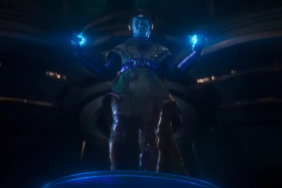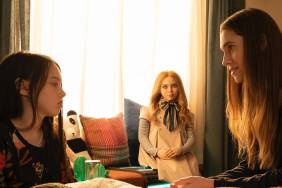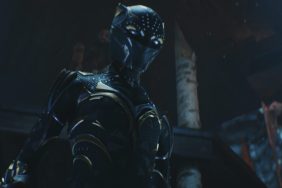
With The Mummy, Alex Kurtzman is launching a new wave of Universal Monsters
With The Mummy trailer now online, fans finally have their first good look at what the film’s tagline calls “a new world of gods and monsters.” After all, The Mummy is planned as the first entry in a cinematic universe that will introduce new takes on other classic Universal Monsters like the Invisible Man, Frankenstein and the Wolf Man, all within an interconnected continuity. For The Mummy director and producer Alex Kurtzman, however, “new” isn’t necessarily the operative word. While his hope is, like all storytellers, to delight audiences with something they’ve never seen before, he’s also hoping to reignite a legacy as old as the studio itself.
RELATED: The Mummy Trailer is Unleashed!
“‘The Hunchback of Notre Dame” was the first film that Universal ever made,” Kurtzman tells CS. “When I started talking to all the people there, I realized there was this tremendous sense of pride that they had in their monster heritage. They called them ‘Our monsters’… What you will come to understand is that the mummy exists in a continuum of monsters. They have been around for potentially longer than we have. Part of why we wanted to start with the Mummy is because she’s one of the oldest ones.”
Many of the Universal Monsters were originally based on public domain material, but the studio’s cinematic versions have, over the decade, become unchallenged in their popular culture representation. When he boarded The Mummy, Kurtzman sat down with artists and planned updated looks for all of them, even though only two appear in The Mummy.
“Creature from the Black Lagoon, Frankenstein, Bride of Frankenstein, Hunchback, Phantom of the Opera, Dr. Jekyll, The Mummy,” Kurtzman rattles off. “I can go on and on. Wolfman. Universal owns the rights to [Frankenstein]’s bolts-in-the-neck, flat-top head, green face. So now you take all that away, and I’d say, “But it’s still Frankenstein”, you’re going to go, “No, it’s not.” And if you ask a four-year old child to draw Frankenstein for you, they’re going to draw bolts in the neck, flat-top head and green face. It is culturally embedded. That is the world we live in, it’s not going away.”

The challenge then became to balance the character’s iconography against the film’s verisimilitude.
“You look at the Karloff Mummy,” Kurtzman explains, “Which is one of my favorite movies and definitely of the Mummy movies has been the one that’s influenced me the most in the making of this one. It starts with a terrifying scene. The Mummy wakes up, because the words are spoken, and he gets up and he walks out the door. And that’s it. And for the rest of the movie, Karloff’s in a robe. But you don’t remember any of that. What you remember is Karloff in the bandages… There was the question, ‘Well wouldn’t the bandages just fall off her?’ And my feeling was, ‘No! No one gives a sh-t!’ She’s gotta wear the bandages and if you take the bandages off, she’s just a person. That’s where I start to feel like the movies stops to work. So, then it became the fun of, ‘Where do the bandages come from? What’s the story?'”
Because the 1932 Karl Freund The Mummy was itself a contemporary film, Kurtzman immediately knew that he didn’t want to again approach the franchise in the way that director Stephen Sommers did with 1999’s The Mummy.
“[We asked ourselves] ‘What would it be like if we took a real monster and put that monster in our world?,”” Kurtzman continues. “Not in a fake world, but our world. What would that be like? How would it react to us, and how would we react to it? I think that the question of where magic and science meet has always been something that interested me… [O]ne of the things that I loved about The Mummy — that was very unique to both the Mummy and to Dracula — was that the Mummy had the power to mesmerize. Karloff had the power to mesmerize. He could get in your head, he could make you do sh-t. And that was really scary.”
The decision to change the gender of the title monster was one that didn’t happen immediately but that ultimately helped crack the story for Kurtzman. Boris Karloff played a mummy called Imhotep in the 1932 film. For the new movie, Kingsman: The Secret Service and Star Trek Beyond‘s Sofia Boutella is Ahmanet.
“The minute we did that, a whole door opened up,” says Kurtzman. “A whole world opened up. Because her story got to be different, it became ‘What happened to her 5,000 years ago?’ How does SHE become a mummy?”

Ahmanet isn’t the only monster we’re meeting in the new film. The trailer introduces Russell Crowe as Dr. Jekyll. Don’t expect any other monster cameos, though. While other Monsters belonging to the same universe are on the way, Kurtzman stresses that the goal with The Mummy is to make a great one-off film.
“It was something we debated for quite some time,” Kurtzman recalls. “Because there was a couple things we came to understand as we were developing the script. We wanted to understand the context of the mummy in the larger world. And we wanted to know that monsters existed for millennia. And we knew that as the story evolved there was going to be an organization that was maybe cataloging them, following them. Collecting them. That would determine the good ones from the bad ones. That was sort of the keeper of that secret history. And we said, ‘Well, we could make up a character who is going to be the voice of that. Or we can look to monster mythology and ask, ‘Is there a character we can fit into the Mummy story that wouldn’t detract from the Mummy story, but, in fact, enhance it?'”
An important connection formed both between Ahmanet and Jekyll and between Jekyll and Morton, the lead character played by Tom Cruise. As you’ve seen in the trailer, Morton (“Mort” is French for “Death”) has been brought back to life through some mysterious connection to the mummy’s curse.
“I’ve got thirty years of ‘Tom Cruise is Going to Save the Day’ in my understanding of the Tom Cruise movie,” says Kurtzman. “That’s just what I’m going to come to the theater with. Because he always saves the day. And when he said he wanted to do the movie, I couldn’t have been happier. But I quickly realized that the challenge of doing it was going to be a way to remove that from my thinking as an audience member. What really needed to happen was I needed to go, ‘Oh sh-t, he really can’t save the day. He might not save the day.’ And how do we do that? Because the mummy is in your head. And the mummy is making you do things you don’t want to do. And now you’re cursed. And you don’t know what’s going on. You’ve suddenly made a very unreliable protagonist who is dangerous, in a way. And the minute you do that, all bets are off.”

That’s where Kurtzman found Jekyll could play an important factor in the story, offering a mirror of Morton and, in doing so, a glimpse at the good and evil split intrinsic to the Robert Louis Stevenson character.
“To have a character who is as morally challenged as Tom’s character at the beginning of the movie,” Kurtzman continues, “Who’s suddenly thrown into a situation that’s going to test where on the spectrum of humanity he really lies. You’re talking now about a character at a movie that’s exploring how much human and how much monster is really going to exist in this guy, and where is the line between them? And both of those two things exist in one character. And one person. Well, I could also be talking about Dr. Jekyll now.”
While The Mummy is aiming to be genuinely scary, Kurtzman is quick to point out what he considers to be the key difference between a horror film and a monster movie.
“I got to the scene where Frankenstein sees the little girl by the water’s edge,” Kurtzman recalls one of his favorite classic scenes. “Frankenstein has just been chased out of town and everyone thinks that Frankenstein is a monster. All Frankenstein wants is to make a human connection and to be loved. Then Frankenstein meets this little girl and, because she’s a child, she just sees a guy who just wants to play. He kneels down with her and there’s this lovely scene. She shows him flowers and she throws flowers in the water. They float and she says, “Isn’t this wonderful?” So he picks her up and throws her into the water and she drowns. As a kid, this really f–ks you up. You have the experience of going, ‘I really feel for this creature, but look at what this creature is capable of doing.” To me, that’s what defines a monster. That’s what separates a monster movie from a horror movie or a slasher movie. It is the ability to fear the monster and to fear for the monster… It speaks to what is psychologically frightening about monster movies. They hit something primal, emotional.”
The Mummy is already set to be followed by new versions of The Wolfman, The Invisible Man, Bride of Frankenstein, and Van Helsing. Whether they’re all going to one day meet up in one big film, however, has not been decided and, for Kurtzman, part of the fun is figuring out how it might eventually work and paying homage to classic monster crossovers like Frankenstein Meets the Wolf Man.

“I’m not going to sit here and pretend I can tell you exactly how they’re all going to come together,” he says. “I think we have a lot of ideas. I mean, we have a *lot* of ideas. And a lot of things that are very exciting. But, to me, the fun of the promise of bringing them together is that they’re probably going to f–k each other up pretty badly… We’re not necessarily going to do ‘The Avengers.’ There might be reasons for this character and that character to come together, because the story tells us that’s what the story wants. The story is what drives the choice. And if down the line, there’s a big reason to bring them together, then great. But I promise, we’re not starting there.”
There is, however, some very cool news for fans of the original films. We asked Kurtzman if there’s any chance that the original films might be considered canon.
“You know what?” said Kurtzman, initially hesitant about the answer, “I will say, absolutely. Those movies exist in continuity.”
Although the recent Dracula Untold is specifically not going to be the version of Dracula featured in the budding monsterverse, including the original monster films means the Monsterverse could suddenly be even bigger than the Marvel Cinematic Universe!
“[But] the only way to do it is to think in terms of not building a universe,” says Kurtzman. “You have to make great individual movies first and foremost. You have to deliver them. If you do that, the audience will follow you. But the audience is going to get you there, not the mandate to do it.”
The Mummy hits theaters June 9, 2017.
(Photo Credit: Nikki Nelson / WENN.com)









